by Dr Aboudé Haddad, Director of Engineering, FrigoDynamics® Europe Ltd
Introduction
Conventional light sources have always been able to release heat to the ambient through infrared radiation, and convection in the case of Fluorescent. This mode of heat transfer typically does not require advanced cooling methods to facilitate the process. LED sources however lose heat through conduction, which requires the additional knowledge of how to carry waste heat out of the LED efficiently in order to prevent system failure. An overview of the different modes of heat loss for various light sources can be seen in table 1.

Note: HID = High Intensity Discharge
This mode of heat loss shown by LEDs puts them in the same category of thermal solution design needs as processors. However since approximately 16% - 20% of energy consumption comes from lighting, the LED market is pushing high demands on eco friendly solutions. For this reason passive means are the prime methods to be considered to cool LEDs and modules. The issue is that many commercial and industrial LED applications have such demanding thermal needs that conventional passive cast or extruded heat sinks can no longer do the job, due to the thermal limitations of the materials used. Furthermore their substantial weight along with significant and substantial performance degradation when changing orientation signifies that things must change.
These limitations of conventional passive heat sinks result in the increased use of active solutions. Active systems however have further drawbacks including, operating cost, reliability issues, performance degradation over time and increased audible noise levels. Table 2 gives an overview of the main pros and cons of typical passive and active cooling means. As can it be seen, none of these methods meet all requirements but rather there is a clear split of pros and cons.
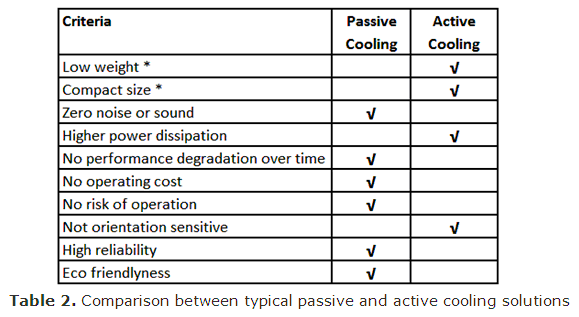
The Passive Revolution
Recently a new breed of passive cooling solutions have come to the high brightness LED market, utilizing 2-Phase heat transfer. The HPK-Fin™ 2-Phase heat exchangers solutions. They aim to combine the advantages of both active and passive systems.
Technology
2-Phase heat transfer devices only require the disposable heat in order to initiate their powerful heat transfer cycle. “2-Phase” in this case means the use of evaporation and condensation in order to dramatically increase the heat transfer characteristics of the device. The process operates in a hermetically sealed tube, filled with a minute quantity of liquid and happens at nearly the speed of sound. Figure 1 outlines this mechanism. These devices have been field tested in the military and various commercial industries for decades, proving their reliability in electronic systems.
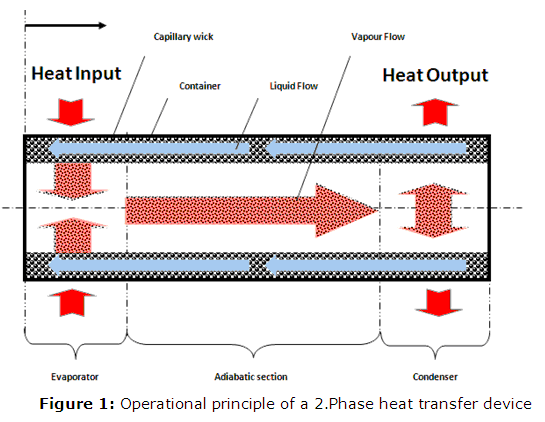
The effective thermal conductivity across a 2-Phase heat transfer device can be up to several hundred times greater than an equivalent aluminum or copper rod. The process can even work independent of the orientation that the device is positioned at. A comparison of thermal conductivity of various materials compared to a 2-Phase heat transfer device can be seen in the Table 3.

The FrigoDynamics® patented passive HPK-Fin™ coolers for the Solid State Lighting industry integrate this 2-Phase technology (See Figure 2). Due to the extremely high heat transfer rate, FrigoDynamics® HPK-Fin™ 2-Phase heat exchangers save on material usage thus making them resource saving units without compromising cooling performance. They achieve this in an entirely passive manner.
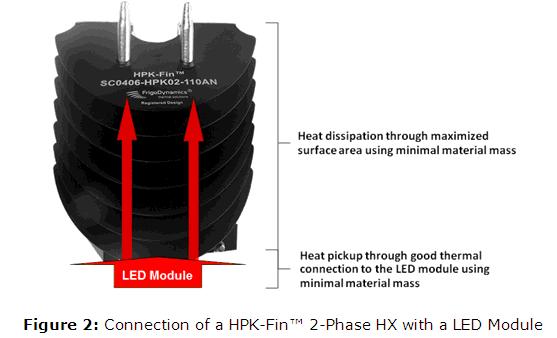
Thermal Tests
In order to demonstrate the effectiveness of these passive HPK-Fin™ 2-Phase heat exchangers, the following test samples were used (see Figure 3):
• Xicato XSM: 2000lm 36W LED source
• FrigoDynamics® SC HPK-Fin™ 150 2-Phase heat exchanger
It is important to show that the HPK-Fin™ 2-Phase heat exchangers can work at any orientation as could be demanded by the application, hence a series of tests were carried out with all of the orientations shown in Figure 4.
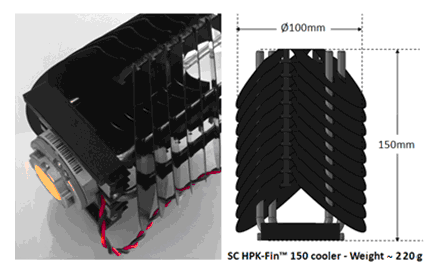
Figure 3: FrigoDynamics® SC HPK-Fin™ 150 2-Phase heat exchanger with 36W Xicato XSM LED (2000lm)
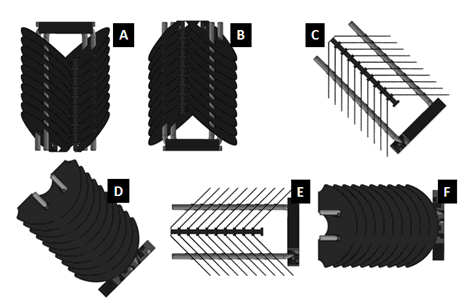
Figure 4: Orientation of test cases (A-Vertical down, B-Vertical up, C-45⁰ closed, D-45⁰ open, E-Horizontal closed, F-Horizontal open)
The key measurement to be made is that of the Tc point temperature on the LED case itself. This is the temperature on the LED surface that contacts to the HPK-Fin™ 2-Phase heat exchanger. For this particular LED module (Xicato XSM), the maximum allowable Tc temperature is 90⁰C, in order to guarantee lumens and 50K hours of operation.
Chart 1 shows the test results at an ambient temperature of 40⁰C. As it can be seen, the Tc point is at around 70⁰C, giving a margin of 20⁰C on the maximum allowable temperature. Furthermore, it is clear that at different orientations, very little effect on performance can be seen. Such a healthy performance margin in practice would mean that one could either:
• Extend the lifetime of the LED way beyond 50K hours
• Use an even higher lumen module
Such high performance levels of a 2-Phase heat exchanger that weighs at little as ~ 220g and operates greatly in any orientation is extremely effective considering it is an entirely passive cooling solution.

Chart 1: Test results of FrigoDynamics® SC HPK-Fin™ 150 2-Phase heat exchanger at different orientations using 36W Xicato XSM module
Passive cooling heavily relies on surface area for free convection to occur, in contrast to active cooling which places more emphasis on the forced air flow rate. Given that surface area is so important here, it is crucial that the heat can be spread effectively across the available area.
To illustrate this point, the longer SC HPK-Fin™ 230 (230mm) can be seen in front of an infrared (IR) thermal imaging camera in Figure 5. This image demonstrates that the heat is distributed very evenly, at a ΔT less than 2K spread across the full length and surface of the 2-Phase heat exchanger maximizing its passive HPK-Fin™ cooling potential. This is particularly notable when considering that a large amount of heat is coming from a relatively small footprint at the base of the 2-Phase heat exchanger. Just solid extrusions or castings would lead to considerable thermal gradients when subjected to a concentrated heat load, resulting in loss of efficiency at the areas far away from the heat source.
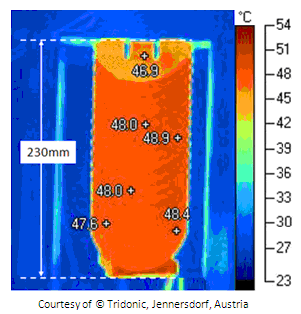
Figure 5: IR camera illustrating effective thermal spreading across full 230mm length of FrigoDynamics® SC HPK-Fin™ 230 2-Phase heat exchanger cooling a Tridonic TALEXXengine STARK SLE with 4000lm
Adaptable Design
The many applications in lighting require solutions to be adaptable enough to fit different product design embodiments. Down lights for example have the mechanics of their solutions hidden behind a recess roof which may vary in height. Spot and track lights on the other hand have the whole product visible and covered by a cylindrical housing. Examples of typical high brightness LED applications that require unique thermal designs are:
• Down lights
• Spot Lights
• Wall washers
• High Bay
• Street lights
As illustrated in figure 6, FrigoDynamics® HPK-Fin™ 2-Phase heat exchangers can be designed into various different shapes and can be tailor made to meet both envelope and thermal requirements. This combined with the high thermal capabilities, scalability and ability to work at any orientation, allows for these 2-Phase heat exchangers to fit many applications.
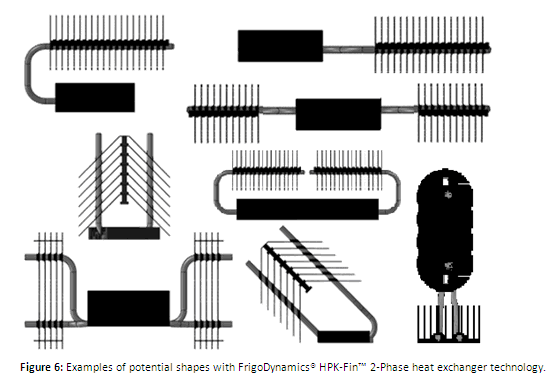
All air cooled solutions, whether active or passive, operate better when in an open air environment. However many applications require that a housing is built around the light engine for aesthetic and safety reasons. FrigoDynamics® solutions with specially designed fins can have enough thermal margin to enable proper operation and cooling inside a housing. However, without airflow passive cooling solutions are rendered useless, thus the designer must ensure that correctly situated air inlet and outlet ventilation holes are available. Consultation on design assistance at an early stage is essential.
One such recent example can be seen in Figure 7, where the SC110 FrigoDynamics® HPK-Fin™ 2-Phase heat exchanger is integrated into the AlphaLED™ Metropole light fixture, enabling high performance in an entirely passive fashion and with a very light weight design.
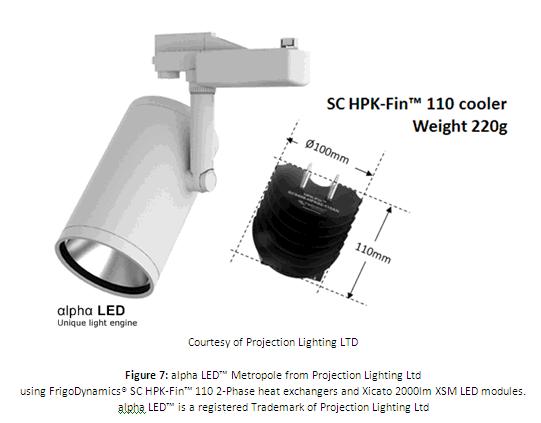
Conclusions
FrigoDynamics® advanced passive HPK-Fin™ 2-Phase heat exchangers are extremely effective, light weight, eco friendly, 100% recylable and easy to apply cooling solutions. They pose neither cost nor risk of operation thus are the most cost effective Solid State LED cooling solutions available. They are particularly well suited to cooling high power LEDs with a small heat source foot print due to being able to efficiently spread heat across all areas of the 2-Phase heat exchanger regardless of heat source size and meeting challenging ΔT requirements.
The HPK-Fin™ 2-Phase heat exchanger designs can be adapted to meet many different form factors that an unique application may require. Furthermore HPK-Fin™ 2-Phase heat exchangers can be scaled up or down to meet the precise thermal requirements of the application and still remain cost effective.
Test results demonstrate that 2-Phase technology can successfully be used to design a fully passive LED 2-Phase heat exchanger capable of combining the advantages of both conventional passive and active 2-Phase heat exchangers into a single advanced passive design. An overview of all advantages can be seen in table 4.
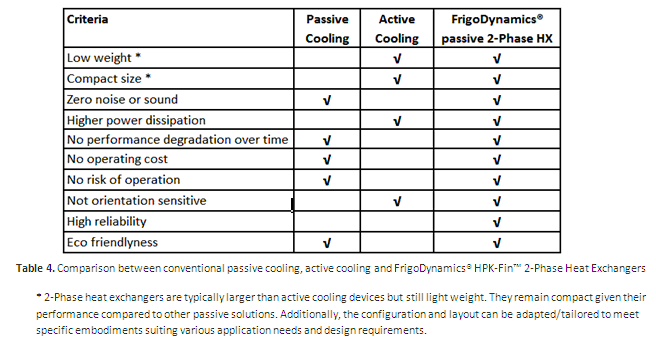
About Frigodynamics®
Frigodynamics® is a leading thermal solutions provider specialising in the Solid State Light Emitting Diode Market. We provide standard and custom designed solutions. We have a team of seasoned experts in the field of 2-Phase heat transfer and other cooling technologies with vast experience in development, design, production and marketing of application specific thermal solutions. We strive to achieve the benefit of innovation by challenging prior assumptions and eliminating historical limitations. Our goal is to provide environmentally friendly and easy to use solutions cost effectively and challenge preconceptions by providing thermally sound designs.
Frigodynamics® has capabilities in Germany, the United Kingdom, Spain and PR China.





 CN
TW
EN
CN
TW
EN

















